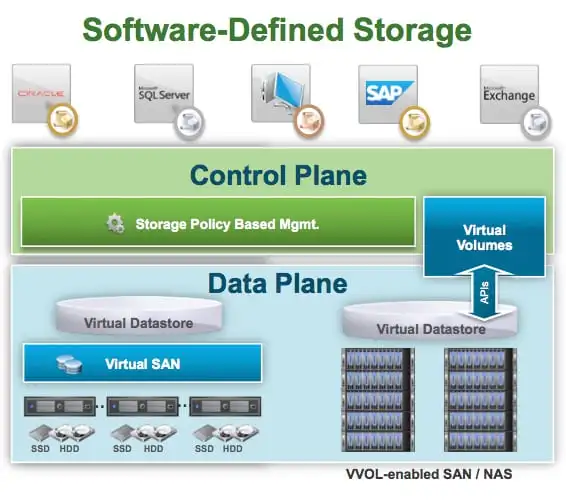Request a Demo
Join a 30 minute demo with a Cloudian expert.
VMware provides a variety of ways for virtual machines to access storage. It supports multiple traditional storage models including SAN, NFS and Fiber Channel (FC), which allow virtualized applications to access storage resources in the same way as they would on a regular physical machine. It also supports Software-Defined Storage (SDS) models that allow you to create and scale elastic pools of storage, and centrally manage data protection and data backup.
VMware storage is highly flexible, supporting on-premise, public cloud and hybrid cloud deployments.
This is part of an extensive series of guides about hybrid cloud.
In this article:
VMware provides several virtualized storage options as part of vSphere, its virtualization platform. vSphere provides two categories of storage models, traditional storage and distributed storage based on the Software-Defined Storage (SDS) paradigm.
| Traditional Storage Models | Software-Defined Storage Models |
|
|
VMware offers a variety of storage models that use traditional storage protocols, allowing you to easily import existing workloads from a non-virtualized environment.

Source: VMware
vSphere offers the following traditional storage options:
On an individual VM, vSphere supports the following types of virtual machine disks (VMDK):
vSphere supports the following types of physical disks attached to a VM:
In a software-defined storage (SDS) model, virtual machines become storage units that can be elastically provisioned according to vSphere policies.

Source: VMware
vSphere SDS encompasses the following technologies:
VMware provides, as part of the vSphere stack, a component for intelligently managing storage, both at the virtual machine level and at the network file system level. That component is SDRS, which watches consumption of storage resources in the cluster and can allocate additional resources on demand.
SDRS can either change storage provisioning automatically, or send messages to administrators notifying them that resources are running low or are over-utilized. SDRS provides the following main capabilities:
VMware data centers based on traditional storage infrastructure can be difficult to manage. As virtualized workloads scale up and down, you may find yourself purchasing, installing and configuring physical hard disks, RAID systems, etc.
Cloudian HyperStore is an on-prem, enterprise storage solution that is certified for use in VMware environments, and enables easy scalability from hundreds of Terabytes to Exabytes to support any scale of data. HyperStore supports both traditional storage protocols like SAN and NAS, but at its core it is based on a Software-Defined Storage paradigm, managing dynamic pools of object storage.
HyperStore is used in demanding operator-scale deployments using VMware vCloud Director.
Learn more about Cloudian’s solutions for VMware storage.
VMware offers several virtualized storage options as part of vSphere. It supports many traditional storage models including NFS, SAN, and Fiber Channel (FC), which enables virtualized applications to access storage resources. It also supports Software-Defined Storage (SDS) models that enables you to create and scale elastic pools of storage.
There’s a lot more to learn about VMware storage. To continue your research, take a look at the rest of our blogs on this topic:
VMware Data Protection is EOA: 5 Great Alternatives
VMware Data Protection (VDP) was a backup solution offered as part of the vSphere stack. VMware announced End of Availability (EOA) for VDP back in 2017, and End of General Support (EOGS) in March 2020. This means that existing deployments are no longer supported.
Since the EOA announcement, VMware users are migrating to third-party backup solutions. There are various available solutions that offer all the capabilities of VDP and more. This article reviews 5 solutions you can use for VMware backup.
Read more: VMware Data Protection is EOA: 5 Great Alternatives
VMware Backup: Three Approaches
Data backup is a critical part of any data center. That’s why you need to create a solid backup and restore strategy, when operating VMware virtualized resources. This article reviews three backup methods: backing up VMs as physical machines, using a dedicated virtualization backup solution, and backing up VM files.
Read more: VMware Backup: Three Approaches
VMware Cloud Director 101: Architecture, Features and Concepts
VMware Cloud Director turns a physical data center, or multiple data centers distributed across multiple locations, into virtual data centers. Within these data centers, Cloud Director enables elastic network provisioning, storage and compute resource provisioning, and allows public cloud providers define services and offer them to users..
This article reviews the basic structure and concepts of VMware Cloud Director, and shows how you can easily manage huge storage volumes.
Read more: VMware Cloud Director 101: Architecture, Features and Concepts
Getting to Know VMware Site Recovery Manager (SRM)
Disaster recovery is a critical part of any data center. VMware offers a dedicated solution for disaster recovery, as part of the vSphere stack, called VMware Site Recovery Manager (SRM). SRM is a backup automation tool that supports policy-based management of backup programs, and provides a replication technology. SRM can perform orchestration of recovery programs to reduce downtime in times of disasters. In addition, it enables you to run non-disruptive testing of disaster recovery plans.
Read more: Getting to Know VMware Site Recovery Manager (SRM)
See Additional Guides on Key Hybrid Cloud Topics
Together with our content partners, we have authored in-depth guides on several other topics that can also be useful as you explore the world of hybrid cloud.
Authored by cloudian
Authored by Atlantic
Authored by Komodor